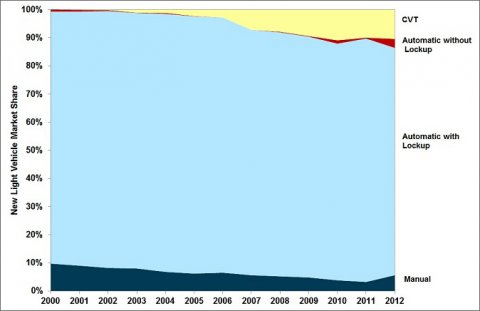The variety of transmission technologies has increased as manufacturers seek more efficient ways of transferring power from the engine to the wheels of the vehicles. Automatic transmissions with lockup remain the dominant transmission type but Continuously Variable Transmissions (CVT) have seen greater use in recent years, accounting for about 10 percent of all transmissions between 2010 and 2012. The number of automatic transmissions without lockup (shown in red in the figure below) dropped to zero by 2006. Beginning in 2008, however, new technology was employed which raised the share of automatic without lockup transmissions to 3.2% percent by 2012. The dual clutch automatic transmissions, which are mechanically similar to manual transmissions but they shift automatically, are not equipped with a lock-up torque converter. Standard manual transmissions have declined from nearly 10% in 2000 to a low of 3.2% in 2011 but rebounded somewhat in 2012.
Market Share by Transmission Type, Model Years 2000-2012
Supporting Information
| Model Year | Manual | Automatic with Lockup | Automatic without Lockup | CVT |
|---|---|---|---|---|
| 2000 | 9.7% | 89.5% | 0.7% | 0.0% |
| 2001 | 9.0% | 90.3% | 0.6% | 0.1% |
| 2002 | 8.2% | 91.4% | 0.3% | 0.2% |
| 2003 | 8.0% | 90.8% | 0.1% | 1.1% |
| 2004 | 6.8% | 91.8% | 0.3% | 1.2% |
| 2005 | 6.2% | 91.5% | 0.1% | 2.3% |
| 2006 | 6.5% | 90.6% | 0.0% | 2.8% |
| 2007 | 5.6% | 87.1% | 0.0% | 7.2% |
| 2008 | 5.2% | 86.8% | 0.2% | 7.9% |
| 2009 | 4.8% | 85.5% | 0.2% | 9.4% |
| 2010 | 3.8% | 84.1% | 1.2% | 10.9% |
| 2011 | 3.2% | 86.6% | 0.3% | 10.0% |
| 2012 | 5.6% | 80.8% | 3.2% | 10.4% |
| Source: Environmental Protection Agency, Light-Duty Automotive Technology, Carbon Dioxide Emissions, and Fuel Economy Trends: 1975 through 2012, EPA-420-S-13-001, March 2013. | ||||


